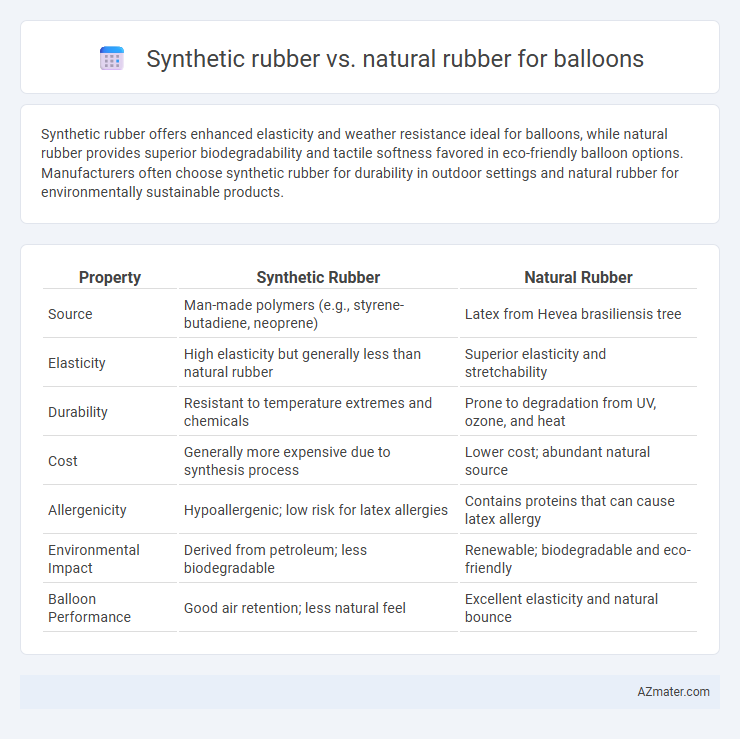Synthetic rubber offers enhanced elasticity and weather resistance ideal for balloons, while natural rubber provides superior biodegradability and tactile softness favored in eco-friendly balloon options. Manufacturers often choose synthetic rubber for durability in outdoor settings and natural rubber for environmentally sustainable products.
Table of Comparison
| Property | Synthetic Rubber | Natural Rubber |
|---|---|---|
| Source | Man-made polymers (e.g., styrene-butadiene, neoprene) | Latex from Hevea brasiliensis tree |
| Elasticity | High elasticity but generally less than natural rubber | Superior elasticity and stretchability |
| Durability | Resistant to temperature extremes and chemicals | Prone to degradation from UV, ozone, and heat |
| Cost | Generally more expensive due to synthesis process | Lower cost; abundant natural source |
| Allergenicity | Hypoallergenic; low risk for latex allergies | Contains proteins that can cause latex allergy |
| Environmental Impact | Derived from petroleum; less biodegradable | Renewable; biodegradable and eco-friendly |
| Balloon Performance | Good air retention; less natural feel | Excellent elasticity and natural bounce |
Introduction to Balloon Materials
Synthetic rubber, primarily composed of polymers like styrene-butadiene and neoprene, offers superior uniformity, elasticity, and resistance to environmental factors compared to natural rubber. Natural rubber, derived from latex harvested from Hevea brasiliensis trees, provides excellent tensile strength and flexibility but is more vulnerable to degradation from oxygen, ozone, and UV light. Balloon manufacturers often choose synthetic rubber materials for enhanced durability and color retention, while natural rubber remains favored for its biodegradability and traditional elasticity.
What is Natural Rubber?
Natural rubber is an elastic substance harvested from the latex sap of rubber trees, primarily Hevea brasiliensis. It features superior flexibility, resilience, and biodegradability compared to synthetic rubber. These properties make natural rubber ideal for balloons, offering excellent stretchability and a soft, tactile feel that synthetic alternatives often lack.
What is Synthetic Rubber?
Synthetic rubber is a man-made elastomer produced through the polymerization of petroleum-based monomers such as styrene and butadiene, offering enhanced durability and resistance to environmental factors. It provides consistent quality and improved elasticity compared to natural rubber, making it ideal for balloon manufacturing where reliability and performance are crucial. Unlike natural rubber derived from latex sap, synthetic rubber resists degradation from UV light, ozone, and temperature fluctuations, ensuring longer-lasting balloons.
Production Processes Compared
Synthetic rubber for balloons is produced through polymerization of monomers such as styrene and butadiene using controlled chemical processes, allowing precise adjustment of properties like elasticity and durability. Natural rubber, derived from latex harvested from Hevea brasiliensis trees, undergoes coagulation, drying, and vulcanization, relying on biological extraction methods that introduce variability in quality. The synthetic rubber production process offers greater consistency and scalability, while natural rubber provides biodegradability but with more complex supply chain dependencies.
Environmental Impact: Synthetic vs Natural Rubber
Synthetic rubber production relies heavily on petrochemicals, resulting in higher carbon emissions and non-biodegradable waste, negatively impacting the environment. Natural rubber, derived from Hevea brasiliensis trees, is biodegradable and renewable, promoting sustainability through carbon sequestration in rubber plantations. However, natural rubber cultivation can lead to deforestation and biodiversity loss if not managed responsibly.
Durability and Performance in Balloons
Synthetic rubber offers enhanced durability and greater resistance to heat and ozone, making it ideal for balloons exposed to varying environmental conditions. Natural rubber provides superior elasticity and a softer texture, contributing to better stretchability and bounce in balloons, but it degrades faster under UV light and oxygen exposure. For high-performance balloons that require longevity and consistent shape retention, synthetic rubber is the preferred material, while natural rubber excels in applications demanding high elasticity and tactile sensitivity.
Allergy and Safety Concerns
Synthetic rubber balloons, typically made from materials like neoprene or styrene-butadiene, present fewer allergy risks compared to natural rubber latex balloons, which often trigger allergic reactions due to latex proteins. Natural rubber latex can cause severe allergic responses in sensitive individuals, including hives, respiratory issues, and anaphylaxis, making synthetic alternatives safer for public use. Choosing synthetic rubber balloons enhances safety, particularly in environments such as schools and hospitals where latex allergies are a critical concern.
Cost Analysis: Natural vs Synthetic Rubber
Natural rubber, derived from latex of rubber trees, generally incurs higher raw material costs due to agricultural dependency and seasonal fluctuations. Synthetic rubber, produced from petrochemical sources, offers more consistent pricing and can be less expensive, especially when crude oil prices are stable or low. Balloon manufacturers often select synthetic rubber to balance cost efficiency and performance, although natural rubber's elasticity and biodegradability remain appealing for premium products.
Biodegradability and Sustainability
Natural rubber balloons exhibit superior biodegradability due to their organic latex composition, breaking down more efficiently in the environment compared to synthetic rubber alternatives. Synthetic rubber balloons, typically derived from petrochemicals, pose sustainability challenges as they degrade slowly and contribute to long-term pollution. Choosing natural rubber balloons supports eco-friendly practices by reducing plastic waste and promoting renewable resource use.
Choosing the Best Rubber for Balloons
Synthetic rubber, such as styrene-butadiene rubber (SBR) and polyisoprene, offers superior uniformity, durability, and resistance to environmental factors like UV radiation and ozone, making it ideal for balloons used in outdoor or long-term settings. Natural rubber, derived from latex, provides exceptional elasticity, flexibility, and a softer texture, which contributes to easy inflation and a smooth finish preferred for decorative and party balloons. When choosing the best rubber for balloons, synthetic types excel in longevity and weather resistance, while natural rubber remains favored for its biodegradability and superior stretchability in conventional balloon applications.

Infographic: Synthetic rubber vs Natural rubber for Balloon
 azmater.com
azmater.com